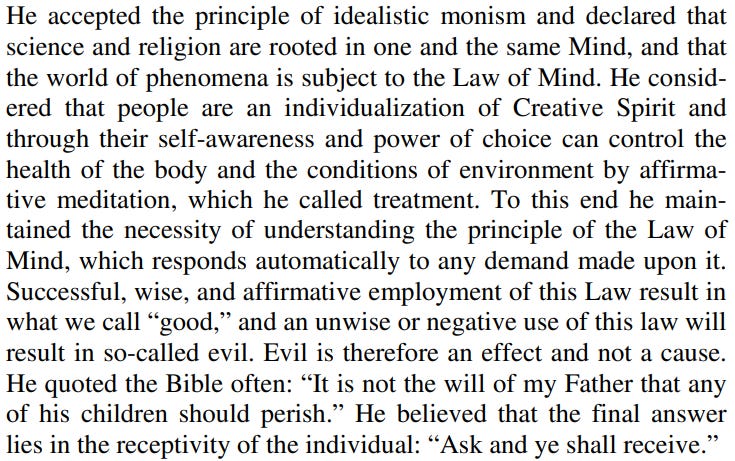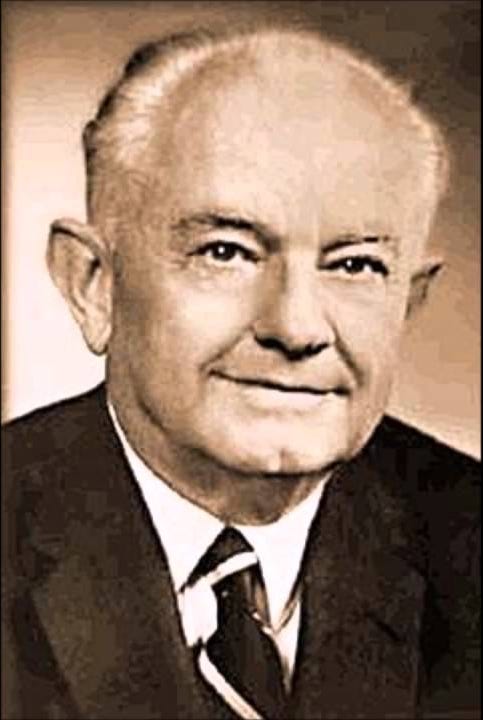Ernest Holmes has been a mentor of mine for over 20 years. Have I read all his works? No, I haven’t, but that’s precisely why I’m reviewing some of his most potent ideas.
Holmes developed “The Science of Mind” as a spiritual philosophy, taking the best of what was in the domain of spiritual ideas. He simplified and synthesized the deepest of wisdom traditions. It’s been said that he could pretty much deliver his teaching in short order, reminding his students of only the most potent bits required to walk this spiritual path.
It wasn’t but a few short moments with one of his pages that my life had changed. I still have that book and cherish the tattered corners where I spilled a dark soda of some kind on it. The curious thing is that I had pet rats at the time, and before long, those corners had been chewed up by tiny rat teeth. You can see the grooves of their work and can almost feel their excitement from taking a bite out of wisdom. That’s what we’re here for today.
Images and Words: Tracing Thought Through Metaphor
I want to get creative with the philosophy set here. Holmes may as well have called it “The Science of Heart,” and perhaps I read that he had considered that as a possible title somewhere, and it stuck. I can’t be sure.
Holmes himself said, “Religious Science is a synthesis of the laws of science, opinions of philosophy, and revelations of religion, applied to human needs and the aspirations of humankind.”

If you are not well pleased with the conditions of your life and you have decided to change them, Holmes would say, "Give the Law New Instructions."
This law functions much like the physical laws of nature, which helps us recognize that the law is impersonal, predictable, and universally applicable.
The Creative Law responds to the thoughts, beliefs, and intentions we project into it, producing experiences that align with those mental and emotional states.
Understanding Religious Science: The Core Principles of Ernest Holmes’ The Science of Mind
The Science of Mind is a spiritual philosophy and movement founded in the early 20th century. At its heart, this philosophy seeks to unite spirituality and science, emphasizing the power of thought and belief in shaping one’s experience of reality.
While not a traditional religion with fixed dogmas or rituals, Religious Science offers a framework for understanding the divine nature of the universe and the individual’s role in co-creating their life.
I have explored the idea of “Beliefs” in a prior post. I find it worthwhile to rethink and question our beliefs as a process of self-discovery.
“Beliefs are Dynamic Narratives. They are fluid stories we tell ourselves and others, which evolve as we gain new insights and experiences. These narratives are not fixed but adaptable, allowing for continuous growth and transformation.” - LuminalMind
What is Religious Science?
Religious Science can best be described as a philosophy of mind (heart even), a spiritual system that teaches the unity of all life, the interconnectedness of thought and experience, and the existence of an infinite intelligence that Holmes called the "Universal Mind." According to Holmes, this Universal Mind, or Spirit, is the creative force behind everything in existence, including human beings. Because we are expressions of this divine intelligence, we have the power to shape our lives through our thoughts, beliefs, and actions.
At its core, Religious Science is built on the idea that our thoughts create our reality. This concept is rooted in the New Thought movement, which Holmes was deeply influenced by, and it shares some principles with metaphysical teachings like the Law of Attraction.
The Science of Mind teaching is more than positive thinking; it offers a structured way to align one’s consciousness with universal principles to manifest a more fulfilling and spiritually aligned life.
Core Principles of Religious Science
The Oneness of All Life Religious Science teaches that there is only one infinite power and presence in the universe, which Holmes referred to as Spirit, God, or the Universal Mind. Everything in the cosmos is an expression of this singular source, and as such, all life is interconnected. This means that each person is not separate from the divine but a unique and individualized expression of it. The core of this principle is unity—we are all part of the same spiritual essence.
The Power of Thought A central tenet of The Science of Mind is that our thoughts and beliefs shape our experience of reality. Holmes believed that by aligning our thoughts with higher spiritual truths, we could direct the creative force of the universe to bring about desired outcomes. This is where the power of affirmations and visualization comes into play. By focusing on positive, life-affirming thoughts, individuals can manifest health, abundance, love, and peace.
Creative Law In Religious Science, the Universal Mind operates through what Holmes called the Creative Law. This law functions much like the physical laws of nature—impersonal, predictable, and universally applicable. The Creative Law responds to the thoughts, beliefs, and intentions we project into it, producing experiences that align with those mental and emotional states. This is the mechanism behind the idea that "thoughts are things." If you think, believe, and act in ways that are harmonious with your goals and higher self, the law will respond accordingly, bringing those outcomes into your life.
The Spiritual Nature of Humanity Religious Science holds that human beings are spiritual beings having a physical experience. Because we are expressions of the divine, we carry within us unlimited potential for growth, healing, and transformation. This principle encourages individuals to look beyond their perceived limitations and recognize the infinite possibilities available to them when they align with their true spiritual nature. As spiritual beings, we are endowed with the same creative power that governs the universe, allowing us to be active participants in our personal and collective evolution.
Personal Responsibility and Self-Empowerment One of the most empowering aspects of Religious Science is its emphasis on personal responsibility. The philosophy teaches that we are not victims of circumstance but creators of our experience. By understanding that we shape our reality through our thoughts, we are encouraged to take responsibility for our inner world—our beliefs, attitudes, and choices. This isn't about blaming oneself for life’s difficulties but about realizing that we have the power to transform those challenges by shifting our consciousness. Through self-reflection, meditation, and spiritual practice, we can change the mental patterns that create our experiences.
Healing Through Spiritual Practice Healing is a fundamental aspect of Religious Science, with the belief that physical, emotional, and spiritual healing can be achieved by aligning one’s consciousness with the divine truth of wholeness. The method of healing practiced within Religious Science is called spiritual mind treatment, a type of affirmative prayer that involves recognizing the oneness of all life, affirming the desired outcome, and releasing the need for it to manifest in any particular way. The idea is that by aligning our thoughts with the truth of divine perfection, we allow that perfection to be expressed in our lives, whether through healing the body, resolving financial difficulties, or improving relationships.
Spiritual Evolution Religious Science teaches that spiritual evolution is a continuous process for both the individual and humanity as a whole. Life is seen as a journey of constant growth and expansion, with the ultimate goal being the realization of one’s true spiritual nature. This process of self-realization involves breaking free from limiting beliefs, expanding consciousness, and cultivating a deeper awareness of one’s connection to the divine. Every experience, whether joyful or challenging, is viewed as an opportunity for spiritual growth.
The Role of Faith in Religious Science
Faith in Religious Science is not blind belief. It is an understanding of the principles of the universe and trust in the Creative Law’s ability to respond to our thoughts. It’s a faith based on knowledge, not superstition. It’s an inner conviction that by aligning with spiritual truth, we activate the creative forces that bring about transformation. Faith, in this context, becomes a tool for manifesting the highest good in one’s life.
How Religious Science is Practiced
Religious Science is practiced through various spiritual disciplines aimed at cultivating a deeper connection with the divine and aligning one’s consciousness with universal principles. These practices include:
Affirmative Prayer (Spiritual Mind Treatment): This is the foundational practice where individuals affirm spiritual truths and their desired outcomes in alignment with divine laws.
Meditation: Quieting the mind to tune into the presence of the Spirit and develop inner awareness.
Visualization: Imagining and emotionally experiencing the desired outcome as though it has already occurred.
Gratitude Practice: Acknowledging and giving thanks for the good that already exists, which opens the mind to greater abundance.
Study and Contemplation: Reading spiritual texts and contemplating their meanings and applications in daily life.
In today’s world, where science and spirituality are often seen as opposing forces, The Science of Mind offers a compelling bridge between the two. By teaching that spiritual laws are as consistent as physical ones and that our thoughts and beliefs shape our reality, Religious Science presents a path for personal empowerment and spiritual growth. It invites individuals to take an active role in creating their lives, to heal through the power of the mind, and to recognize their oneness with the divine. Whether seeking healing, prosperity, or a deeper understanding of life’s purpose, The Science of Mind provides a framework for living a more harmonious and spiritually aligned life.
We are going to continue this with a series of future posts. Be on the lookout for an even deeper synthesis and some additional creativity in the weeks to follow.



